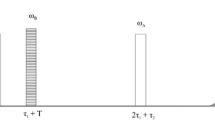Abstract
A theoretical study of the effect of microwave (MW) fields of finite amplitude on the process of pulsed electron-electron double resonance (PELDOR) signal formation is carried out. It is shown that the behavior of the experimentally observed values can be described by four vectors of partial magnetizations whose motion is reduced to precession in effective magnetic fields. In the case of strong spin-spin interaction, the PELDOR effect can be observed when a sufficiently powerful MW field is applied at pumping frequency to affect both components of the Pake doublet. The possibility of a “two-frequency” spin echo to appear under the action of two pulses with different carrier frequencies in the system where the inhomogeneous broadening of the electron spin resonance line contour is mainly determined by the dipole-dipole interaction is demonstrated.
Similar content being viewed by others
References
Salikhov K.M., Semenov A.G., Tsvetkov Yu.D.: Electron Spin Echo and Its Applications. Novosibirsk: Nauka 1976. (in Russian)
Raitsimring A.M., Salikhov K.M.: Bull. Magn. Reson.7, 184 (1985)
Milov A.D., Maryasov A.G., Tsvetkov Yu.D.: Appl. Magn. Reson.15, 107 (1998)
Milov A.D., Maryasov A.G., Tsvetkov Yu.D., Raap J.: Chem. Phys. Lett.303, 135 (1999)
Maryasov A.G., Tsvetkov Yu.D., Raap J.: Appl. Magn. Reson.14, 101 (1998)
Milov A.D., Salikhov K.M., Schirov M.D.: Fiz. Tverd. Tela23, 975 (1981)
Berliner L.J. (ed.): Spin Labeling: Theory and Applications. New York: Academic Press 1976.
Klauder J.R., Anderson P.W.: Phys. Rev.125, 912 (1962)
Salikhov K.M., Dzuba S.A., Raitsimring A.M.: J. Magn. Reson.42, 255 (1981)
Maryasov A.G., Dzuba S.A., Salikhov K.M.: J. Magn. Reson.50, 432 (1982)
Abragam A.: Principles of Nuclear Magnetism. Oxford: Clarendon Press 1961.
Bedilo A.F., Maryasov A.G.: J. Magn. Reson. A116, 87 (1995)
Ernst R.R., Bodenhausen G., Wokaun A.: Principles of Nuclear Magnetic Resonance in One and Two Dimensions. Oxford: Clarendon Press 1987.
Mims W.B.: Rev. Sci. Instrum.10, 78 (1965)
Pannier M., Veit S., Godt A., Jeschke G, Spiess H.W.: J. Magn. Reson.142, 331 (2000)
Author information
Authors and Affiliations
Rights and permissions
About this article
Cite this article
Maryasov, A.G., Tsvetkov, Y.D. Formation of the pulsed electron-electron double resonance signal in the case of a finite amplitude of microwave fields. Appl. Magn. Reson. 18, 583–605 (2000). https://doi.org/10.1007/BF03162305
Received:
Revised:
Issue Date:
DOI: https://doi.org/10.1007/BF03162305



